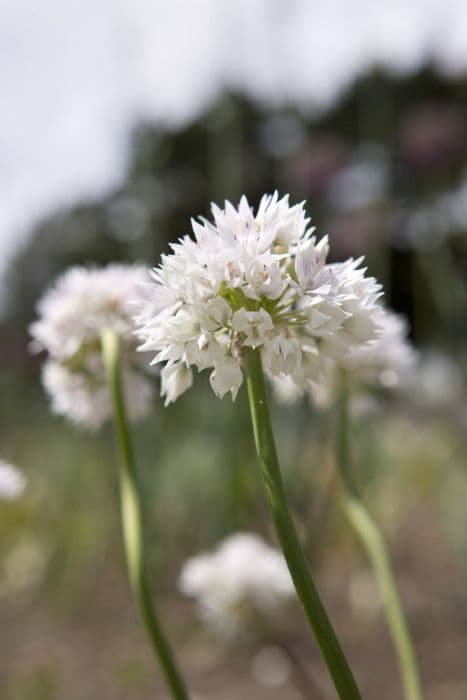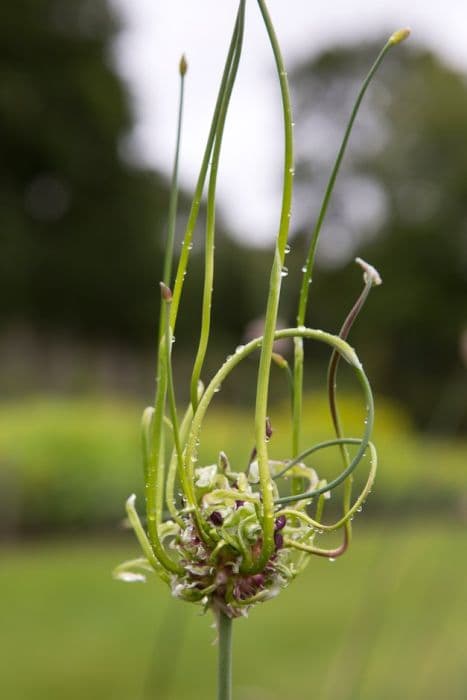Turkestan onion Allium karataviense 'Ivory Queen'

ABOUT
The 'Ivory Queen' is a distinctive and ornamental plant known for its large, rounded clusters of star-shaped flowers that are a creamy white color. These flowers bloom atop sturdy, short stems which are embraced by broad, glaucous, grayish-green leaves that can have a slight twist. The leaves are quite substantial and may have a slight waxy coating, giving them a rich, lush appearance. The overall effect of the flower heads against the wide foliage is one of robust fullness and elegance. The plant has a compact habit and the blooming period is during the spring season. The 'Ivory Queen' is a variety that is often appreciated for its decorative appeal and is frequently used in rock gardens, borders, and as attractive ground cover. Its globular flower shape and the subtle beauty of its white blossoms make it a popular choice for ornamental gardening.
About this plant
 Names
NamesFamily
Amaryllidaceae
Synonyms
Karataviense Onion, Ivory Queen, Turkestan Onion
Common names
Allium karataviense Regel, Allium leuconium Kar. & Kir.
 Toxicity
ToxicityTo humans
The toxicity of Turkish onion (Allium karataviense 'Ivory Queen') to humans is generally considered low. Allium species can contain compounds that can be irritating to the skin, mouth, stomach, and intestines if ingested in large quantities. While they are not typically considered toxic to humans, eating large amounts of any part of the plant could potentially cause gastrointestinal discomfort, nausea, vomiting, or diarrhea. However, accidental ingestion of small amounts is unlikely to cause harm to most individuals.
To pets
Turkish onion (Allium karataviense 'Ivory Queen') is toxic to pets, especially cats and dogs. All members of the Allium genus contain compounds that can cause toxicity in animals if ingested. Symptoms of poisoning in pets may include vomiting, diarrhea, abdominal pain, lethargy, increased heart rate, and drooling. In severe cases, ingestion can lead to oxidative damage to red blood cells resulting in hemolytic anemia. If you suspect your pet has ingested any part of this plant, it is important to contact a veterinarian immediately.
 Characteristics
CharacteristicsLife cycle
Perennials
Foliage type
Deciduous
Color of leaves
Blue-green
Flower color
White
Height
8 inches (20 cm)
Spread
12 inches (30 cm)
Plant type
Bulb
Hardiness zones
4
Native area
Central Asia
Benefits
 General Benefits
General Benefits- Low Maintenance: 'Ivory Queen' is known for being an easy-to-care-for plant that doesn't require a lot of attention once established.
- Drought Tolerance: This plant can survive in dry conditions, making it suitable for water-wise gardens.
- Attracts Pollinators: It produces flowers that attract bees, butterflies, and other beneficial pollinators to your garden.
- Deer and Rodent Resistance: The plant is resistant to nibbling by deer and rodents, thanks to its onion-like characteristics.
- Ornamental Appeal: 'Ivory Queen' offers striking foliage and attractive blooms, adding aesthetic value to garden spaces.
- Compact Growth: It has a compact growth habit, making it an excellent choice for borders, rock gardens, and container plantings.
- Seasonal Interest: This plant provides seasonal interest with its lush, broad foliage and spectacular spring blooms.
- Easy Propagation: It can be propagated easily from bulb offsets, making it simple for gardeners to expand their collection or share with others.
- Edibility: Its bulbs are technically edible, adding a bonus for those interested in growing their own food, although primarily grown for ornamental purposes.
 Medical Properties
Medical PropertiesThis plant is not used for medical purposes.
 Air-purifying Qualities
Air-purifying QualitiesThis plant is not specifically known for air purifying qualities.
 Other Uses
Other Uses- Allium karataviense 'Ivory Queen', commonly known as Turkestan onion, can be used as a natural fencing when planted in dense rows due to its compact growth and attractive foliage, providing a living boundary that's both functional and aesthetic.
- The dense floral clusters of the Turkestan onion are sometimes used in floral arrangements, providing a unique, spherical shape that adds texture and interest to the design.
- In educational gardens, Turkestan onion can be planted to demonstrate bulbous plant growth cycles and offer a hands-on opportunity for learners to observe the development of a unique ornamental bulb.
- Photographers may utilize the exquisite blooms and interesting leaf patterns of Turkestan onion for macro photography subjects, capturing the intricate details of the flowers and foliage.
- Culinary artists sometimes use the dried flower heads of Turkestan onion as an ornamental garnish for specialty dishes, despite the plant not commonly being used for consumption.
- The plant can be incorporated in xeriscaping due to its low water requirements, making it ideal for water-wise gardens focused on drought-tolerant plants.
- Gardeners may use Turkestan onion as a trap crop to distract pests such as aphids from more susceptible plants, due to its strong scent and hardy nature.
- This plant can serve as a teaching tool for pollination biology, attracting pollinators such as bees and butterflies, which provides an observable ecosystem for study.
- It can be used as a companion plant in a vegetable garden, where its strong odor might help to deter certain pests from more vulnerable crops.
- In colder climates, Turkestan onion can be grown in containers and brought indoors during winter months to add greenery and serve as a reminder of the spring to come.
Interesting Facts
 Feng Shui
Feng ShuiThe Turkestan onion is not used in Feng Shui practice.
 Zodiac Sign Compitability
Zodiac Sign CompitabilityThe Turkestan onion is not used in astrology practice.
 Plant Symbolism
Plant Symbolism- Unity and Humility: The humble appearance of 'Ivory Queen' with its clustered formation signifies individuals standing together in unity while maintaining modesty.
- Good Fortune: In some cultures, blooming 'Ivory Queen' flowers are believed to bring good fortune to the household.
- Strength and Patience: 'Ivory Queen', as part of the allium family, represents the ability to withstand adverse conditions, symbolizing both strength and patience.
- Prosperity and Success: With its robust growth and lush appearance, it is often associated with prosperity and success in various aspects of life.
- Purity and Peace: The ivory color of its blooms can symbolize purity, innocence, and peace, echoing the color's traditional meanings.
 Water
WaterThe Turkish onion 'Ivory Queen' should be watered moderately. When the top inch of the soil feels dry to the touch, it's time to water the plant thoroughly, allowing the water to penetrate deeply to encourage strong root growth. Typically, this might equate to watering once every week or two, depending on the climate and weather conditions, but always check the soil moisture first. During the growing season in spring and summer, they may need more frequent watering, especially in dryer conditions, while in the cooler months, watering frequency should be reduced. It's important to avoid overwatering, as this can lead to bulb rot, so provide enough water to keep the soil evenly moist without becoming waterlogged, which might be around 1 gallon per week during active growth.
 Light
LightTurkish onion 'Ivory Queen' thrives in full sun to partial shade. The best spot for this plant would receive direct sunlight for at least 6 to 8 hours a day. If positioned in partial shade, ensure it gets bright indirect light for the remainder of the day.
 Temperature
TemperatureThe Turkish onion 'Ivory Queen' prefers temperatures in the range of 60 to 70 degrees Fahrenheit for optimal growth. It can withstand minimum temperatures of around 50 degrees Fahrenheit and maximum temperatures up to 80 degrees Fahrenheit. The ideal range should be maintained for the healthiest bulb and flower development.
 Pruning
PruningPruning Turkish onion 'Ivory Queen' is generally not needed for the health of the plant but may be done to remove spent flower heads to maintain a tidy appearance. After the flowers fade and the leaves begin to yellow, you can cut the stems back to the base of the plant. Pruning should be done annually, typically after the flowering period in late spring or early summer.
 Cleaning
CleaningAs needed
 Soil
SoilThe Turkish onion 'Ivory Queen' thrives best in a well-draining soil mix that includes loam, sand, and compost, ideally with a pH range of 6.0 to 8.0. A mix of one-third garden soil, one-third sand or perlite, and one-third compost or well-rotted manure will create an optimal environment for this ornamental allium.
 Repotting
RepottingTurkish onion 'Ivory Queen' typically doesn't need frequent repotting and can be repotted every 3 to 4 years or when it's clearly outgrown its current container. Offset bulbs can be divided during repotting to propagate new plants.
 Humidity & Misting
Humidity & MistingThe Turkish onion 'Ivory Queen' is tolerant of a wide range of humidity levels and does not require special humidity conditions; average room humidity is typically adequate for this hardy plant.
 Suitable locations
Suitable locationsIndoor
Plant in sunny spot with well-draining soil mix.
Outdoor
Use well-draining soil, full sun, and protect from extreme wet.
Hardiness zone
3-9 USDA
 Life cycle
Life cycleThe life of the 'Ivory Queen' Turkish Onion (Allium karataviense 'Ivory Queen') begins with seed germination, occurring in the spring when soil temperatures warm up. Seedlings emerge and grow into bulbs, which is the plant's storage organ. The plant grows foliage and a stout stem, which will support the flower head, typically in late spring and early summer. The globe-shaped, ivory-white flower head blooms, attracting pollinators like bees. After flowering, it sets seeds which can disperse in the environment, or the plant can propagate vegetatively by offsets. The above-ground foliage dies back by late summer, and the plant goes dormant, with the bulb surviving underground until the next growing season.
 Propogation
PropogationPropogation time
Spring
Propogation: The 'Ivory Queen' turban garlic, a cultivar of Allium karataviense, is typically propagated by dividing the bulbs. The optimal time for this process is in the late summer to autumn period, after the foliage has died back. For propagation, carefully dig up the clump of bulbs and gently separate the individual cloves ensuring that they have a portion of the base plate, which is necessary to produce roots. Replant the cloves immediately at a depth of three times their height and space them approximately 8 inches (20 centimeters) apart to give them enough room to grow. Water the newly planted cloves well to help establish them. This method is popular because it maintains the cultivar's characteristics and usually results in flowering plants within a year or two.








